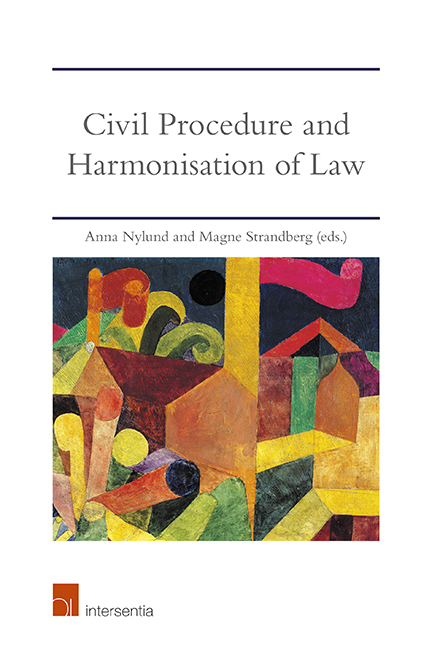Book contents
- Frontmatter
- Preface
- Contents
- List of Contributors
- List of Abbreviations
- Introduction
- EU Civil Justice at the Harmonisation Crossroads?
- The ELI-UNIDROIT Project: An Introduction and an English Perspective
- Europeanisation of Civil Procedure: Overcoming Follow-Up Fragmentation through Bottom-Up Harmonisation?
- Harmonisation or Fragmentation of National Law? An East Nordic Perspective
- An Examination of the Influence of European Union Law on English Civil Procedure
- The EU's Influence on Norwegian Civil Procedure through National Substantive Law
- Consumer Protection and EU-Driven Judicial Activism in the Netherlands
- The Role of the Judge in Consumer Cases – A German Perspective
- Ex Officio Application of the Unfair Terms Directive Cases against Consumers: A Swedish Perspective
- Ex Officio Application of EU Consumer Protection Law in Norwegian Courts
- Maintenance and Multi-Level Harmonisation: A European Union Perspective
- Family Maintenance and Multi-Speed Integration: A Norwegian Perspective
- Conclusions on Civil Procedure and Harmonisation of Law
- About the Editors
Conclusions on Civil Procedure and Harmonisation of Law
Published online by Cambridge University Press: 30 March 2019
- Frontmatter
- Preface
- Contents
- List of Contributors
- List of Abbreviations
- Introduction
- EU Civil Justice at the Harmonisation Crossroads?
- The ELI-UNIDROIT Project: An Introduction and an English Perspective
- Europeanisation of Civil Procedure: Overcoming Follow-Up Fragmentation through Bottom-Up Harmonisation?
- Harmonisation or Fragmentation of National Law? An East Nordic Perspective
- An Examination of the Influence of European Union Law on English Civil Procedure
- The EU's Influence on Norwegian Civil Procedure through National Substantive Law
- Consumer Protection and EU-Driven Judicial Activism in the Netherlands
- The Role of the Judge in Consumer Cases – A German Perspective
- Ex Officio Application of the Unfair Terms Directive Cases against Consumers: A Swedish Perspective
- Ex Officio Application of EU Consumer Protection Law in Norwegian Courts
- Maintenance and Multi-Level Harmonisation: A European Union Perspective
- Family Maintenance and Multi-Speed Integration: A Norwegian Perspective
- Conclusions on Civil Procedure and Harmonisation of Law
- About the Editors
Summary
INTRODUCTION
As the book has provided us with a range of perspectives on the effect of European and international hard law, case law and soft law on national civil procedure law, it is now time to provide over-arching and comparative perspectives. Drawing on the earlier chapters, our aim is to shed light on some of the questions raised. Are some of the north-western European jurisdictions more affected by European rules than other jurisdictions? Are such effects also seen in national court practice? Are there discussions on the methods for implementing EU/EEA law in these jurisdictions?
Although these questions are general in the sense that they concern all types of European and international influence on national civil procedure, we will structure our discussion along the same lines as the structure elsewhere in the book. Most of the discussion will focus on comparisons within the topics found in the previous parts of the book (sections 2 – 5), but we will also compare the impact of each type of law and discuss selected over-arching issues (section 6).
HARD LAW INFLUENCE ON NATIONAL CIVIL PROCEDURE
During the last two decades or so, the list of EU regulations and directives concerning civil procedure law has become long and rich. The list includes a number of regulations and directives that primarily concern matters of civil procedure, especially for cross-border cases, and those that primarily concern a certain branch of substantive law but nonetheless include certain procedural rules for that law. A characteristic feature of these directives and regulations is their fragmented nature – they either apply only to cross-border cases or only to certain substantive cases. Hence, the EU approach to civil procedure differs from the national approach, where civil procedure law is typically regulated in general codes providing rules for all sorts of civil cases.
As is noted by several authors in their chapters, it is challenging to incorporate fragmented EU hard law into a general national civil procedure law system. Incorporation is discussed in particular by Wolfgang Hau, who lists three possible kinds of voluntary over-implementation of EU hard law for the purpose of maintaining a coherent national regulation of procedural matters in general.
- Type
- Chapter
- Information
- Civil Procedure and Harmonisation of LawThe Dynamics of EU and International Treaties, pp. 231 - 242Publisher: IntersentiaPrint publication year: 2019
- 4
- Cited by



